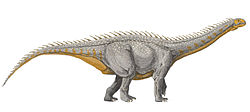Description
The holotype of Zapalasaurus consists of a single vertebrae from the middle of the neck, a fragment of a sacral vertebra, 17 caudal vertebrae, the left ischium and pubis, a fragment of an ilium, a partial left femur, and the left tibia. Zapalasaurus can be distinguished from other diplodocoids based on several features of the cervical neural arches as well as caudal vertebrae which double in length from front to back. [1]
Zapalasaurus is assumed to have a long neck which would have been developed for feeding adaption, allowing its neck to swing in an arc like shape. This would allow Zapalasaurus to browse a wide variety of plants and greens without having to walk very far. [2] [3]
Paleoenvironment
Zapalasaurus was discovered in sedimentary rocks of the La Amarga Formation, which is part of the Neuquén Basin and dates to the Barremian and late Aptian of the Early Cretaceous. Most vertebrate fossils, including Zapalasaurus, have been found in the lowermost (oldest) part of the formation, the Puesto Antigual Member. This member is approximately 29 meters (95 ft) in thickness and mainly composed of sandstones deposited by braided rivers. [5] The sauropod fauna of the La Amarga Formation was diverse and included the dicraeosaurids Amargasaurus and Amargatitanis , and unnamed remains of basal titanosauriforms. [6] The high diversity suggests that different sauropod species exploited different food sources in order to reduce competition. Basal titanosauriforms showed proportionally longer necks, longer forelimbs, and broader tooth crowns than dicraeosaurids and rebbachisaurids, suggesting greater feeding heights. [7] Amargatitanis and Amargasaurus probably fed above ground level at heights of up to 2.7 meters (8.9 ft), as evidenced by the anatomy of their neck and inner ear. Rebbachisaurids like Zapalasaurus presumably fed at ground-level, while basal Titanosauriforms exploited food sources at higher levels. [7]
Other dinosaurs of the La Amarga Formation include an indeterminate stegosaur; predatory dinosaurs include the small ceratosaur Ligabueino , and the presence of a large tetanuran is indicated by teeth. [8] Other than dinosaurs, the formation is notable for the cladotherian mammal Vincelestes , the only mammal known from the Early Cretaceous of South America. [9] Crocodylomorphs are represented by the trematochampsid Amargasuchus. [10]
This page is based on this
Wikipedia article Text is available under the
CC BY-SA 4.0 license; additional terms may apply.
Images, videos and audio are available under their respective licenses.











